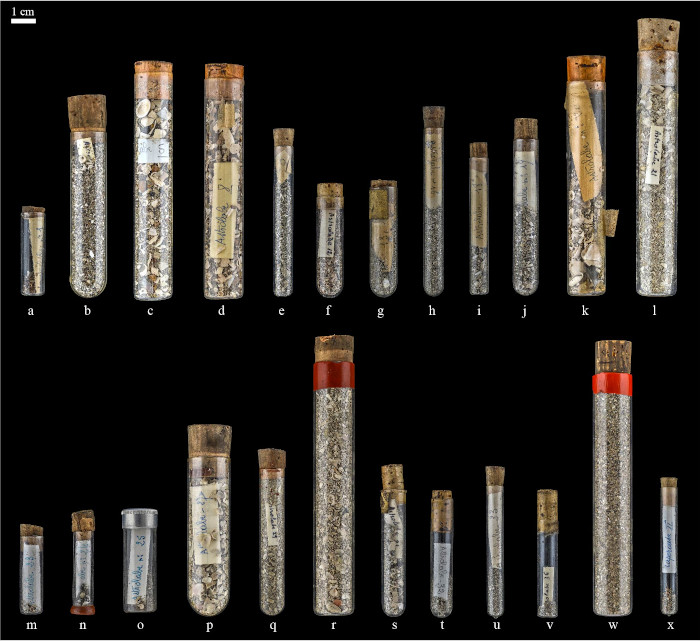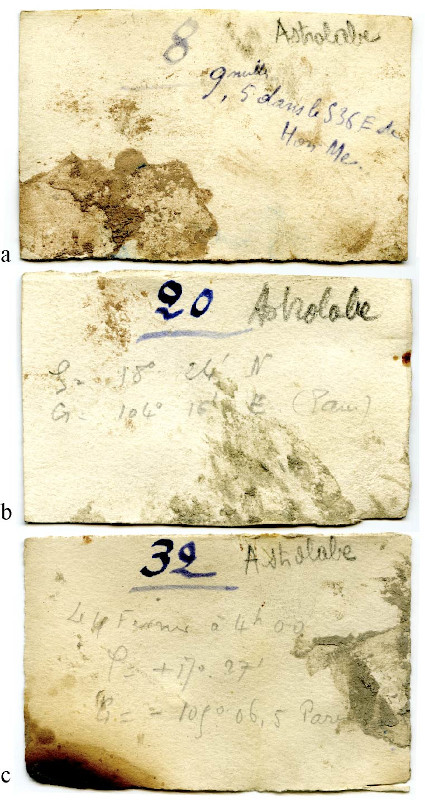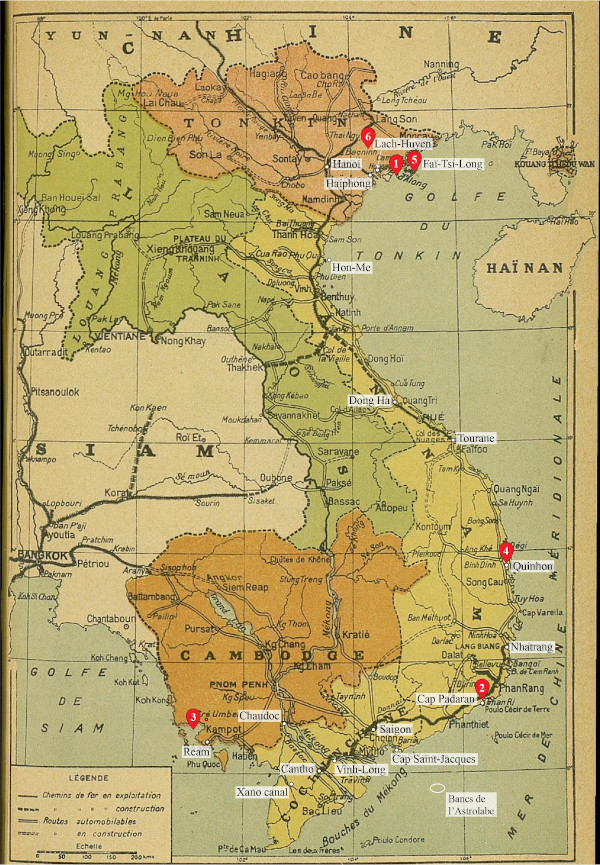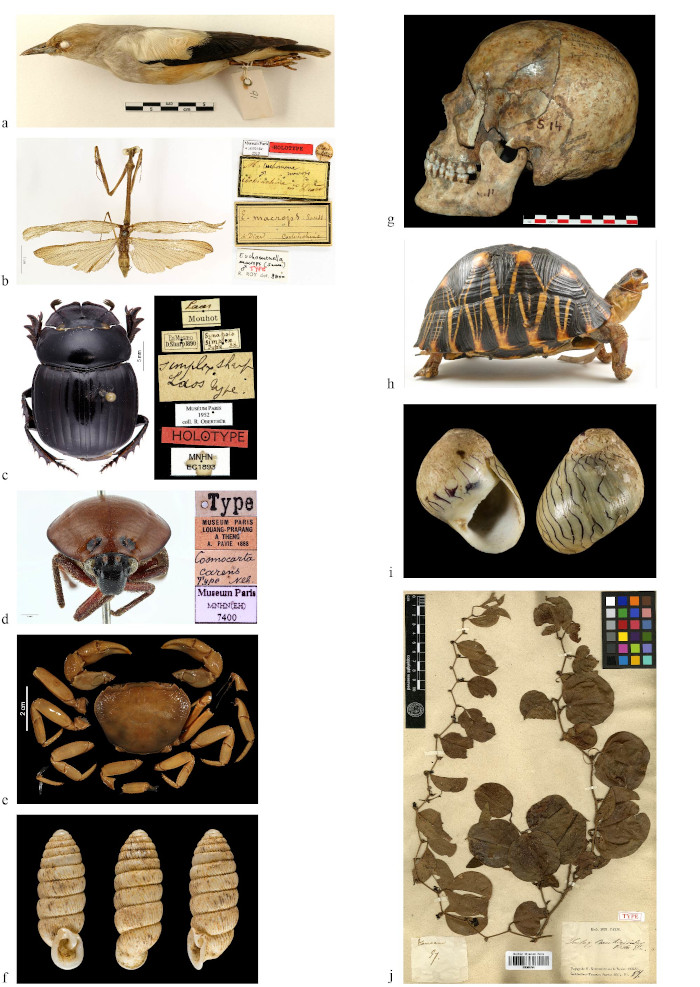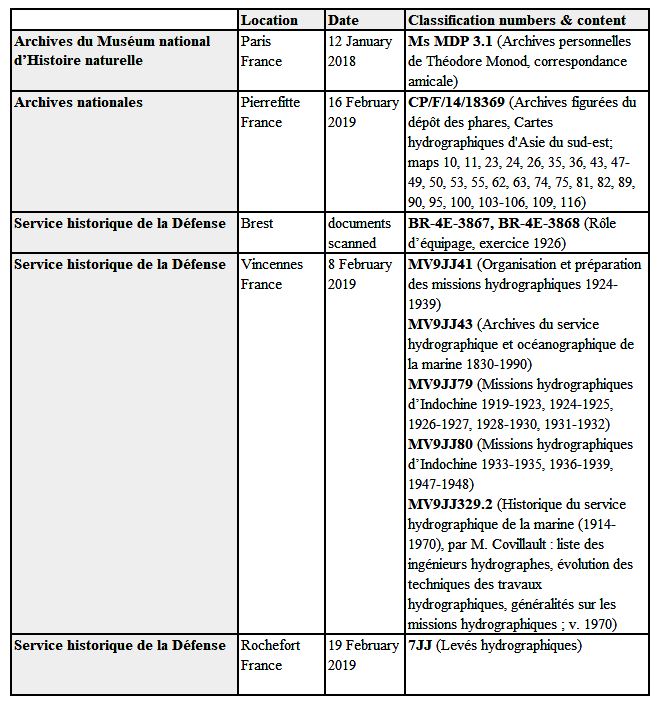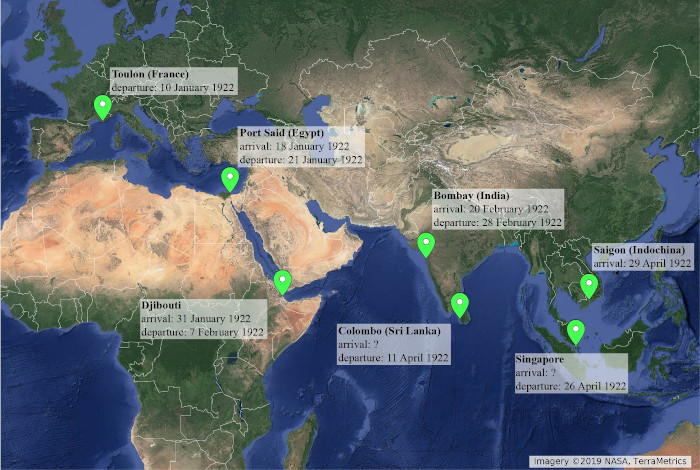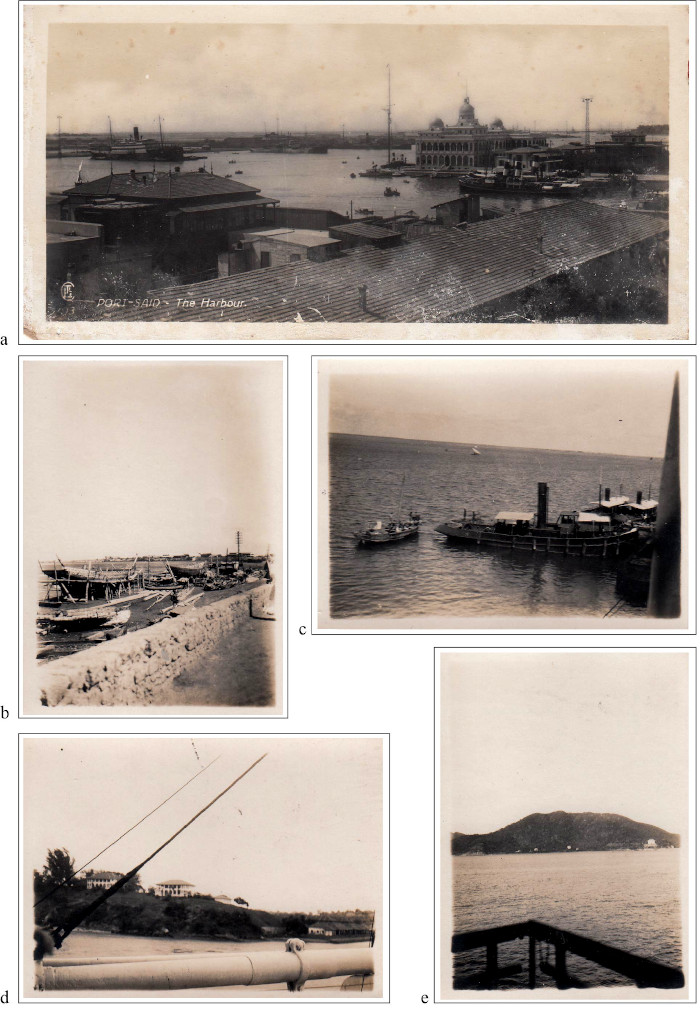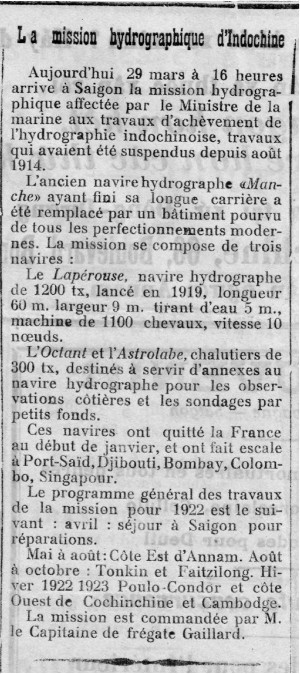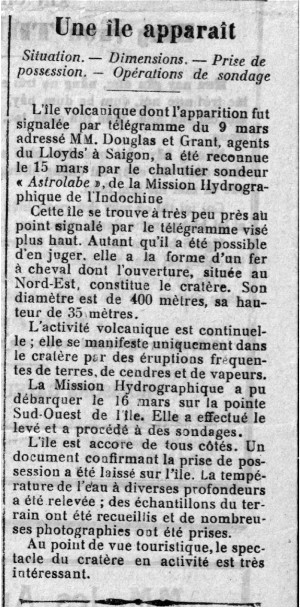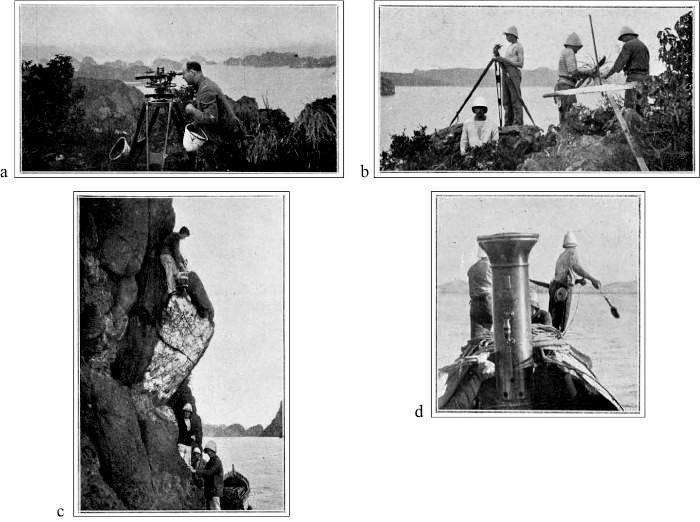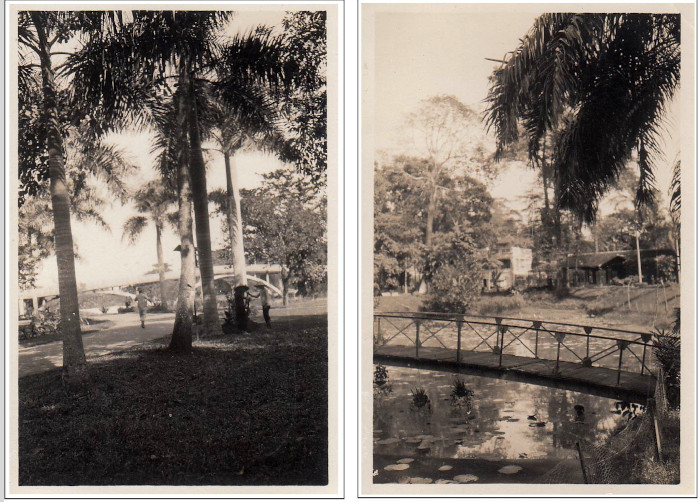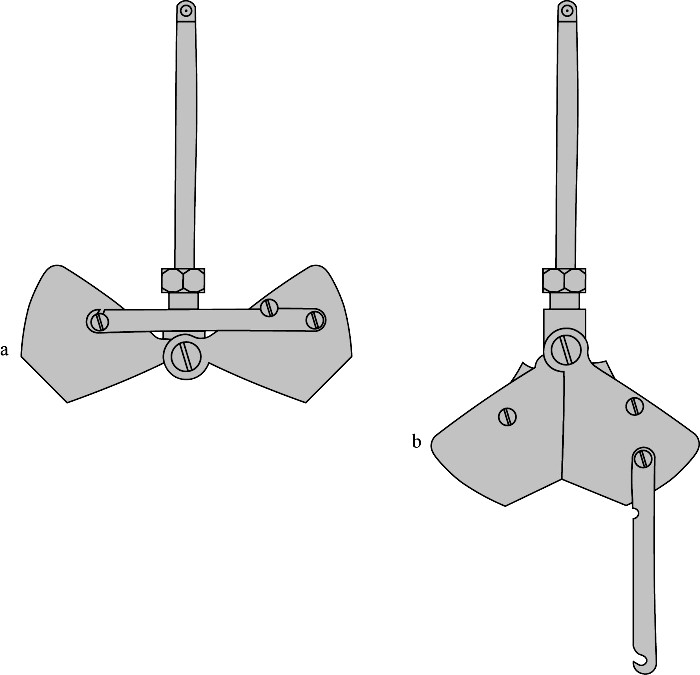Natural history collecting by the Navy in French Indochina
Les collectes d'histoire naturelle par la marine en Indochine française
- Marie-Béatrice Forel
|
The micropalaeontology collections stored in the Muséum national d’Histoire naturelle, Paris, France (MNHN) house collections that paved the way to micropalaeontology. They also contain sea-bottom sediments from marine expeditions that are still poorly documented. Of them, the Lapérouse collection was recently re-discovered. The history of this collection is traced back to the interwar period when three ships of the French Hydrographic Service, Lapérouse and its annexes Astrolabe and Octant, were sailing back and forth along the Indochina coasts to produce navigation maps. Natural history specimens were also collected, from fishes to sponges, most of which are stored in the MNHN. The fate of the ships is described, from their involvement in World War I, their arrival in Indochina to their disappearance during World War II. The contribution of the French Hydrographic Service in Indochina to the natural history collections is described, with a special focus on the MNHN. Keywords: Muséum national d’Histoire naturelle - Lapérouse - Astrolabe - Octant - French Hydrographic Service - French Indochina Les collections de micropaléontologie conservées au Muséum national d’Histoire naturelle, Paris, France (MNHN) abritent des collections qui ont ouvert la voie à la micropaléontologie. Elles contiennent également des sédiments de fonds marin provenant d'expéditions maritimes encore mal documentées. Parmi elles, la collection Lapérouse a été récemment redécouverte. L'histoire de cette collection remonte à l'entre-deux-guerres lorsque trois navires du Service hydrographique français, Lapérouse et ses annexes Astrolabe et Octant, naviguaient dans les deux sens le long des côtes indochinoises pour produire des cartes de navigation. Des spécimens d'histoire naturelle ont également été collectés, des poissons aux éponges, dont la plupart sont conservés au MNHN. Le sort des navires est décrit, depuis leur implication dans la Première Guerre mondiale, leur arrivée en Indochine jusqu'à leur disparition pendant la Seconde Guerre mondiale. La contribution du Service hydrographique français en Indochine aux collections d'histoire naturelle est décrite, avec un focus particulier sur le MNHN. Mots clés : Muséum national d’Histoire naturelle - Lapérouse - Astrolabe - Octant - Service hydrographique - Indochine française |
Description of the Lapérouse collection
Geographical and historical contexts of Indochina
Origin and history of the Lapérouse collection
Material and methods: contextualisation process
The pre-Indochina period and the ships’ characteristics
Lapérouse, Astrolabe and Octant: from Toulon to Saigon
Lapérouse, Astrolabe and Octant missions in 1926
Collecting natural history samples in 1926
WWII, Indochina War and post-conflict periods
Indochina Hydrographic Mission and science
The Indochina Hydrographic Mission in 1926
|
The Muséum national d’Histoire naturelle (MNHN) of Paris, France, houses collections of major importance for the history of palaeontology and particularly of micropalaeontology. The contributors to these collections are diverse, from MNHN researchers to institutions such as the Institut Français du Pétrole [French Petroleum Institute] and École des Mines [School of Mines], scientists and explorers such as Théodore Monod, Jean-Baptiste Charcot, Jacques-Yves Cousteau or oceanographic expeditions of major input such as those of the Travailleur and Talisman ships. They include major historical collections such as, to mention just a few: the foraminifera of Alcide d’Orbigny, bought by the MNHN in 1858, which led the groundwork for micropalaeontology and biostratigraphy or Charles Schlumberger’s collection that contains preparations and sections of foraminifera from around the world, with both scientific and pedagogic significance (Vénec-Peyré & Bartolini, 2010). Others paved the way to modern micropalaeontology such as George Deflandre’s collection, who pioneered in the fields of algology, protistology and palaeoprotistology (Deflandre, 1933; 1937; 1938; 1951), or Nicolas Grekoff’s material, which is a key contribution to modern ostracodology (Grekoff, 1951; 1962; Grekoff & Deroo, 1956; Grekoff & Krommelbein, 1967). Besides these central collections, others are mysterious as to their origin and their importance can only be understood once this issue is elucidated. Of them, the Lapérouse collection is composed of glass tubes filled with sediments and Bristol boards. The present contribution is the result of an extensive literature and archive investigation: it describes the history of this material collected in 1926 in the Gulf of Tonkin and along the coast of Annam in what was then French Indochina by the vessel Lapérouse and its two annexes Astrolabe and Octant, from the French Hydrographic Service. Their mission was to map and dredge sediments along the Indochina coast to allow the construction of new navigable areas and harbours for intensified commercial exchanges. Pierre Chevey, at the time assistant in the MNHN, was attaché naturalist to the Indochina Hydrographic Mission in 1925 and 1926; he collected various organisms during this journey (Chevey, 1927a; 1927b) which were later described by himself and other experts. On 25 April 1921, in his speech ‘Studies on Ocean’ given at the Academy of Science of Washington when receiving the Agassiz Medal that commemorates the work of oceanographers, H.S.H. Albert 1st, Prince of Monaco, expressed the importance of the sea in the history of life by stating: “out of the ensemble of the facts concerning the history of sea-organisms I see more convincing grounds arise for regarding the sea as the cradle of life” (Albert 1st, 1921a). The French version of this speech further extends this thought to the importance of exploring and understanding the present and the past of the sea, as well as their relationship: “Et j’ai pénétré aussi loin que j’ai pu dans l’Océanographie où je sentais dormir la solution des grands problèmes de la biologie ; où je voyais se dessiner le domaine le plus puissant des phénomènes physiques et chimiques d’où sont sorties la naissance, la propagation et l’évolution des êtres.” (Albert 1st, 1921b) [And I went as far as I could into Oceanography where I felt the solution to major issues in biology was sleeping; where I saw the strongest domain of physical and chemical phenomena from which emerged the birth, propagation and evolution of beings.] His idea that the sea and the birth, propagation and evolution of life are so tightly related that the sea should be considered as the cradle of life, echoes the World Heritage Site Cradle of Humankind in South Africa protected by UNESCO since 1999. This parallel is further accentuated by his strong position for the protection of oceans, mirroring the ongoing loss of diversity related to human-driven climate change (Barnosky et al., 2011; Mouillot et al., 2015). The present article aims at developing the ideas advocated by H.S.H. Albert 1st, Prince of Monaco, among others. Following the recent demonstration on material collected during the HMS Challenger voyage around the globe from 1872 to 1876 (Rillo et al., 2019), the sea-bottom sediments stored in the MNHN might provide snapshots to describe the changes related to anthropic influence through time and space. The MNHN preserves material collected by the Travailleur and Talisman cruises from 1880 to 1882, the Pourquoi-Pas? in Rockall and Jan Mayen in 1921, the Calypso voyage in the Red Sea in 1952, to cite only a few of them. May these collections and related histories contribute to raise awareness of the beauty and importance of marine environments, in line with so many scientists and explorers.
Description of the Lapérouse collection The Lapérouse collection was recently re-discovered within the micropalaeontology storage in the MNHN. This material is not mentioned in the entry register and lacks associated archives: it is thus not possible to determine who deposited this material and when. The micropalaeontology collections went through a curatorial vacancy after the death of Charles Schlumberger in 1904: during this period, their fate is obscure and they might have been transferred to the invertebrate collections (Vénec-Peyré & Bartolini, 2010). For these reasons, it is difficult to know who dealt with the accession of the Lapérouse collection. The only information at hand is that directly written on the material. The Lapérouse collection consists of: • Twenty-four glass tubes containing sediments (Fig. 1; collection numbers MNHN.F.F62914 to MNHN.F.F62937). All tubes contain a paper label: Lapérouse I, Lapérouse II and 22 bear Astrolabe associated with a number. • Thirty-four handwritten Bristol boards of 8.5-9 cm long and 5.2-6 cm high (Fig. 2; collection numbers MNHN.F.F62938 to MNHN.F.F62971) numbered from 1 to 36 (boards 6 and 35 are lacking). They display longitude referred to Paris, latitude, date ranging from 1 February 1926 (boards 1-4) to 4 February 1926 (boards 32-36) and Astrolabe. Three boards display only geographic information: ‘Mouillage Nord de Hon-Me’ (board 5), ‘4 milles dans le S36E de Hon-Me’ (board 7), ‘9.5 milles dans le S36E de Hon-Me’ (board 8). Most boards display traces of mud, others are partly burnt.
It would have been tempting to rename the collection to avoid the inevitable confusion with the voyage of the Astrolabe and Boussole vessels ordered by King Louis XVI and commanded by comte de La Pérouse that disappeared in the southern Pacific in 1788 (Fremy & Basili, 1990). However, the material of the Lapérouse collection stored in the MNHN contains only two labels referring to Lapérouse (sediment samples Lapérouse I and Lapérouse II): the original decision to name this collection Lapérouse implies that the person who received this material was aware of at least a part of its history, which is detailed in this study. The name Lapérouse is meaningful and the choice is made to keep it. Although information is lacking, it is plausible that Pierre Chevey himself provided the Lapérouse collection to the micropalaeontology division of the MNHN.
Geographical and historical contexts of Indochina The aim of the present description is not to discuss the history and context of French presence in Indochina but to provide elements about the historical and geographical contexts in 1926 when the Lapérouse collection was gathered (Michel, 1991; Simon, 2001). Indochina is a vast peninsula located between the Indian Ocean and the China Sea: it encompasses Burma to the west, Siam (nowadays Thailand) to the centre and Malacca to the south. The eastern part of peninsular Indochina is composed of Tonkin (North Vietnam), Annam (Central Vietnam), Laos, Cambodia and Cochinchina (South Vietnam): together they formed the former French Indochina with the Chinese territory of Kouang-Tchéou-Wan (Fig. 3). The following geographic description is restricted to Tonkin, Annam and Cochinchina that were visited by the Indochina Hydrographic Mission in 1926. All localities in their denominations formerly adapted to French are gathered in Figure 3, which is modified from an historical map of French Indochina and conceived as a geographical guide.
The coasts of French Indochina, thereafter termed Indochina for simplicity, are 2500 km in length. Tonkin is located between China to the north, Laos to the west, Annam to the south, and is bordered by the Gulf of Tonkin to the east. Mountains are present in the northern and western areas and it is drained by the Red River and its tributaries. The north coast of Tonkin is rocky with shallow bays, such as Faï-Tsi-Long and Along, protected by numerous islands. Annam is bounded by Tonkin to the north, Laos and Cambodia to the west and Cochinchina to the south. It is crossed by the Annamite Range that runs parallel to the coast. The eastern slope of the Annamite Range is steep and forms the numerous capes of the Annam coast, such as Cape Padaran. The Annam coast is more than 1200 km in length and is bounded by the South China Sea to the east. Bays are numerous and shallow and many islands are spread offshore. Cochinchina is bordered by Annam to the northeast, Cambodia to the north and bounded by the Gulf of Siam (nowadays Gulf of Thailand) to the southwest and South China Sea to the southeast. It mainly corresponds to the alluvial plain of the Mekong Delta and Donnai Delta. The first contacts between Europeans and Vietnam, Cambodia and Laos occurred in the 16th century first by Portuguese and Netherlands merchants (e.g. Diogo Veloso in 1582), followed by Portuguese and French missionaries (such as Diogo Carvalho in 1615, Alexandre de Rhodes in 1624, Pierre Lambert de La Motte in 1669, François Deydier in 1682, Joao de Loureiro in 1742, Pierre Joseph Georges Pigneau de Behaine in 1767 (Rhodes, [1994, 3rd part: 78-79]; Briggs, 1950; Lacouture, 1991; Maintienne; 1999). One of the major contributions of this early period is the Dictionnaire annamite-latin-portugais (Rhodes, [1991]), which for the first time used a new writing system derived from the Latin alphabet (known today as quốc ngữ, Jacques, 1998). Because of the persecution of Catholics, France intervened in Indochina at the end of the 1850’s under Napoléon III. The objectives of this intervention were also to prevent England from installing in Indochina, to ensure the French influence in the area and to open a southern terrestrial gate to China for business opportunities. First installed in Saigon (known today as Hô-Chi-Minh-Ville) in 1859, which was at that time a fast-growing fishing harbour, France took rapidly control of the Mekong Delta, the richest area of Cochinchina. This domination extended to the entire Indochinese countries through a series of skirmishes, battles and treatises with local authorities, benefiting from their weaknesses and internal disagreements. In 1863, Cambodia was placed under French protectorate to prevent it from being annexed by Siam. Southern Vietnam provinces, later to become Cochinchina, were occupied in 1867. The protectorate was extended to Northern and Central Vietnam by the Tien Tsin Treatise on 9 June 1885: they respectively became Tonkin (capital city Hanoi) and Annam (capital city Hue). The Indochinese Union was created in 1887, Laos being attached later in 1893. French Indochina was really born during the mandate of Paul Doumer as general governor from 1897 to 1902, with a centralized system, an economic development with the growth of harbours mainly in Saigon, the construction of roads, bridges, railways, and the creation of schools, universities and scientific institutions such as the École française d’Extrême-Orient or the Institut Pasteur (1, 2. In spite of important crises in the 1930s that were repressed by army and police, the military presence of Japanese from 1940 and Pearl Harbour on 7 December 1941, this situation did not change until the Japanese takeover of 9 March 1945. The autonomy of the three countries of Indochina under Japanese protection was declared. It was declared a second time for Vietnam on 2 September 1945 following the defeat of Japan by the Vietminh. In the following years, France tried to recapture Indochina but this war was definitively lost following the Diên-Biên-Phu Battle on 7 May 1954. The Geneva agreements in 1954 declared the autonomy of Cambodia and Laos.
A brief history of French scientific sampling in Indochina Until the 1860s, Indochina was closed to foreigners: only a few natural history samples mainly gathered by Diard in 1824 and Mouhot from 1854 to 1861 reached Europe at that time. Pierre-Médard Diard (1794-1863) studied anatomy and zoology with Georges Cuvier. Together with Alfred Duvaucel, stepson of Georges Cuvier, they settled in Chandernagor (India) in a house they turned into a museum, mostly storing specimens collected by local hunters. The first parcel they sent to the MNHN in June 1818 contained specimens collected from the Ganges, Tibet or Sumatra. They later settled in Sumatra where they sampled for instance the famous dugong, a drawing and description of which were used by Saint-Hilaire & Cuvier (1824-1842). Diard then left for Cochinchina, visited Annam and Cambodia and was one of the first European who visited Angkor (Diard, 1863; Peyssonnaux, 1935; Broc, 1992). During his stay, he collected numerous specimens still stored in the MNHN: fishes, birds (Fig. 4A), insects (Fig. 4B), reptiles, and mammals including primates. It is only in 1858 that Henri Mouhot was officially missioned to explore the Mekong Valley, in the context of the establishment of a southern gate to China. He explored the lower basin of the Chao Phraya River in Siam, Cambodia and traced the first itinerary to Laos (Finot, 1908). While exploring Cochinchina in 1859, Henri Mouhot rediscovered Angkor Vat and Angkor Thom: a full description was published in 1863, two years after his death near Luang Prabang (Anonymous, 1863). Some of the insects he collected in Laos and Thailand are stored in the MNHN (Fig. 4C). Later in the 19th century, natural history sampling intensified, especially thanks to diplomats or soldiers commissioned all over Indochina. The MNHN houses numerous geology, zoology, botany, anthropology and palaeontology collections gathered during this period of intense activity. Of them, the ‘Mission Pavie’ visited Indochina from 1879 to 1895 (Maître, 1912). Auguste Jean Marie Pavie (1847-1925), nicknamed “L’exporateur aux pieds nus” [the bare foot explorer], began his career in Indochina in 1869 as a soldier, a period during which he developed his skills for exploration 3. In 1888, at a time when Laos was still not part of Indochina, he became the head of an official mission with scientific, geographic and political objectives. During its period of maximum activity, his mission was composed of about 40 people: topographers, scientists, political and commercial agents, soldiers. The MNHN stores numerous specimens collected by the ‘Mission Pavie’: plants, insects (Fig. 4D), crustaceans (Fig. 4E), fishes, molluscs, arachnids, reptiles, amphibians, mammals… Another important contributor to the MNHN collections from Indochina was Colonel Messager, who gathered a major collection of eastern Asian molluscs (Breure & Páll-Gergely, 2019). Louis Gabriel Martin Messager (1852-1915) was stationed as a soldier in Indochina from 1896 to 1900. During this period, he intensively sampled terrestrial molluscs that are abundantly preserved in the MNHN (Fig. 4F). Ornithological missions were also organized in Indochina, for instance by Jean Delacour, correspondent of the MNHN, in the course of seven expeditions between 1923 and 1939 (Delacour & Jabouille, 1924; Delacour, 1926; Hennache & Dickinson, 2000; Voisin et al., 2004).
Numerous geological researches were carried out in Indochina by French geologists, mainly related to the Indochina Geological Survey created in 1898 (Lepvrier & Janvier, 2008). The geology and palaeontology collections of the MNHN also contain material collected during different periods of French collecting, all originating from Vietnam (some possibly from Laos): primate remains collected by Jacques Fromaget in 1958 (Fig. 4G) and numerous palaeobotanical specimens provided by the Service des Mines du Tonkin [Mining Survey of Tonkin]. In the 1920s, the geologist René-Léon Bourret studied the south Annamite Range, Laos and northeastern Tonkin. He was also a specialist of modern reptiles: his collection is deposited in the MNHN (Fig. 4H). The micropalaeontology department of the MNHN stores an important collection of fusulinids (large Palaeozoic benthic foraminifers) collected by Jean Gubler from 1902 to 1940 from Cambodia, with rock samples, thin sections and field books. Several voyages of scientific exploration sailed to Indochina in the 19th century. Among them, La Favorite travelled twice to the South China Sea (1829-1832 and 1841-1844) where it was missioned to continue the exploration of the Anambas archipelago in Indonesia initiated by Bougainville. Cyrille Pierre Théodore Laplace, commanding La Favorite from 1829 to 1832, had to establish commercial and diplomatic links with the visited countries and to identify areas where warships could be gathered in case of conflict. The vessel focused on seas around India and China and explored the coasts of Cochinchina and Tonkin. François-Edmond Pâris, appointed as hydrographer on board La Favorite, produced hydrographic observations and drawings (Rieth, 1992; Barron-Fortier, 2015). Natural history specimens were also collected by Joseph Fortuné Théodore Eydoux, onboard naturalist, many of which are preserved in the MNHN including rocks, birds, fishes or anthropological remains (Eydoux & Gervais 1833-1839). La Bonite (1836, 1837), commanded by Auguste-Nicolas Vaillant, was appointed for a circumnavigation to accompany consular officers around the globe (Broc, 1995). During this journey, geographical and meteorological observations were performed along the coasts of South America and across the Pacific Ocean, and numerous specimens stored in the MNHN were collected: molluscs (Fig. 4I), amphibians, arthropods, fishes, birds, insects, plants (Fig. 4J) and seeds (Eydoux & Souleyet, 1840-1866; Souleyet, 1852). However, as far as is known, no sediments were documented during these early voyages. Sediments were furthermore only rarely collected and analysed by more recent expeditions. Foraminifers have been documented from the area considered here as detailed below, but the sediment samples of the Lapérouse collection are unique.
Origin and history of the Lapérouse collection Material and methods: contextualisation process Works by Pierre Chevey (1927a; 1927b) are the only references providing information on samples collected during the Lapérouse, Astrolabe and Octant cruise in February 1926. The archives consulted for the present study are summarized in Table 1. When possible, the cited localities are illustrated by postcards and photos taken approximately in 1927 (Fig. 6 & 11), which belong to the personal archives of Robert Létang, director of the Société Indochinoise de charbonnages et de mines métalliques [Indochinese Society of coal and metal mines] in Tonkin from 1927 to 1934.
The pre-Indochina period and the ships’ characteristics From 1865 to the beginning of the 20th century, only limited missions were organized by the French Hydrographic Service along the Cochinchina and Annam coasts. The loss of the cruiser Sully in February 1905, who burst open on a rock at the entrance of the Faï-Tsi-Long archipelago (known as Quảng Ninh) in the Gulf of Tonkin , marked a turning point in the history of hydrographic missions in the area. Topographic studies along the Indochina coasts started all over again from November 1905 to 1914 on the Manche, with a special focus on the Along Bay and Faï-Tsi-Long. After an interruption related to World War I (WWI), the mission resumed in 1922 with the arrival of the ships Lapérouse, Astrolabe and Octant. Missions were organized until the beginning of World War II (WWII) in 1939 4. Lapérouse, Astrolabe and Octant began their careers during WWI when they were respectively called Lapérouse, Mauviette and Pivert. Lapérouse was built in 1918 in Brest arsenal (France) and launched on 21 November 1919; she was an auxiliary tanker whose aim was to provide the logistic support to a French squadron based in Corfu 5. She weighed 526 tons, was 51.25 m long and 7.9 m wide, with a draught of 4.2 m, a power of 1100 horses, a speed of 12 knots, 2 boilers, 1 propeller and a capacity of 40 on-board staff. However, the end of WWI intervened before she was ready for operations. Lapérouse was then transformed for hydrographic missions: she was extended by 12 m, reaching 63.6 m in length and 8.5 m in width, a weight of 781 tons, a draught of 5.5 m and a speed of 11 knots. She was equipped with hoist, ‘White’ crafts formerly disposed on battleships and provided large spaces for secondary boats, drawing rooms and a capacity of 104 on-board staff (Roche, 2005). Lapérouse was not equipped with satisfying food resources to host an important crew: the crew used to embark living cattle, pigs, ducks or chickens 6. Seven submarine hunters built during WWI were transformed into hydrographic annexes: originally, these vessels had birds’ names that were changed to fit their new mission. Among them, the Pivert became the Octant and the Mauviette became the Astrolabe 7. Astrolabe and Octant were built at the Forges et Chantiers de la Méditerranée in La Seyne-sur-Mer (France) and launched in 1918. They both weighed 315 tons, were 43.5 m long and 7.3 m wide, with a draught of 3.6 m, a power of 460 horses, a speed of 10 knots, 2 boilers, 1 propeller and a capacity of 32 on-board staff (Roche, 2005; Estival, 2003). They served as annexes for coastal observations and shallow-water dredging. Lapérouse was originally supposed to be associated with the annexes Astrolabe and Boussole (Roche, 2005) in reference to the vessels commanded by captain Jean-François de Galaup, comte de La Pérouse, missioned by King Louis XVI to complete the discoveries of Cook and Bougainville in the Pacific Ocean. They sunk in 1788 on the reefs of Vanikoro Island in Santa Cruz archipelago, southern Pacific Ocean (Fremy & Basili, 1990). However, the Boussole annex was affected to the North Africa Hydrographic Mission with the Beautemps-Beaupré and Alidade: she was therefore replaced by the Octant to join the Indochina Hydrographic Mission 8. In February 1921, Lapérouse, Astrolabe and Octant were assigned to the Hydrographic Mission along the Morocco and Algeria coasts until the end of October 9, 10. Lapérouse, Astrolabe and Octant: from Toulon to Saigon In September 1921, Lapérouse, Astrolabe and Octant were appointed to the Indochina Hydrographic Mission 11, 12. Several newspapers reported the journey of the survey ships on their way to Saigon: the successive ports of call of the three vessels are shown in Figure 5 and Figure 6. The vessels were free to choose the harbours to stop in depending on their refuelling needs, with the aim of reaching Saigon quickly, avoiding stops in Crete or Italian harbours if possible and staying as short a time as possible in Port Said (Egypt) and in the Suez Canal 13. The ships left Toulon (France) on 10 January 1922 and arrived in Port Said (Egypt) on the January 1922 14, 15, 16. They left on 21 January and reached Djibouti on 31 January 17, 18. They left on 7 February and arrived in Bombay (India) on 20 February 19, 20. They cast off Bombay on 28 February, reached Colombo (Sri Lanka) that they left on 11 April 21, 22. They finally left Singapore on 26 April and reached Saigon at 4pm on 29 April 1922 23, 24, 25 (Fig. 7).
Once in Indochina, the objectives of the ships were to recognize Saigon, Tourane, Haiphong, the southern and eastern coasts of Annam, as well as the coasts of the Gulf of Siam 26, 27 (Fig. 3). The Astrolabe accomplished special missions such as the recognition of a newly accreted volcanic island, called Ile Nouvelle, on 15 March 1923 28, 29 (Fig. 8). She also took part in the rescue of the wreck and survivors of the Cap-Lay liner on 16 July 1928, that had collided with a rock at the entrance of Song Lambac, Haiphong river in Along Bay, during a typhoon, killing 49 30, 31. During the early 1930s, the ships studied the continental shelf offshore Cochinchina and South Annam and discovered shoals and banks (Joubin, 1836). Among them, the Bancs de l’Astrolabe, about 30 miles (about 48 km, Fig. 3) from the coastline at a waterdepth ranging from 4.6 to 8.5 m, are still mentioned as dangerous areas in recent sailing recommendations in the South China Sea (National Geospatial-Intelligence Agency, 2017).
Lapérouse, Astrolabe and Octant missions in 1926 The on-board crew. In 1926, when the Lapérouse collection was gathered, the Indochina Hydrographic Mission was commanded by Commander Dufäy 34 (Fig. 9). The hydrograph in chief was 1st class hydrograph engineer Damiani, assisted by sub-lieutenant Gauthier. Lieutenant Joubin was commanding the Octant and Lieutenant Morazzani commanded the Astrolabe. The officers responsible for the different hydrographic measurements were (Damiani, 1928 ; 35): - Sub-lieutenants Gauthier, Gavoille, Guézennec, de Lajarte, Marchand, Rossignol and Vialet onboard Lapérouse; Pierre Chevey, assistant at the MNHN, was attaché naturalist to the Indochina Hydrographic Mission in 1925 and 1926 (Chevey, 1927a; 1927b; 36). He shared his time between the Indochina Hydrographic Mission onboard the Octant and the Oceanographic Service of the Indochina Fisheries based in Nhatrang in southern Annam, onboard the De Lanessan (Chevey, 1927a; 1927b). He later became head of the Oceanographic Service of the Indochina Fisheries in Nhatrang in May 1931 until his death on 13 July 1942 in Saigon (Serène, 1955). During his stay in Nhatrang, he tried to further develop the Oceanographic institute of Nhatrang by inviting several important scientists of the MNHN, including Théodore Monod whom he repeatedly tried to convince, unsuccessfully, to visit Indochina and the institute he was in charge of 37.
The objectives of the mission. In 1926, the objectives of the Indochina Hydrographic Mission were to continue the topographic studies carried out in 1925 39. It was planned to operate all year round with the possible support of gunboats Malicieuse and Inconstant for dredging as well as sloops Regulus, Bellatrix and Ville d’Ys that could have been requested for hydrographic tasks. The journey of the ships from January 1926 to February 1927 was a round-trip leaving from Tonkin during which they had to characterize the topography of (Damiani, 1928 ; 40): • Along Bay in Tonkin Gulf in January 1926 (Point 1 in Figure 3); For each of these tasks, the crew performed triangulation, water-depth, topographic, currents, tides and magnetic measurements (Damiani, 1928). Triangulation was performed with theodolites using whitewash marks, some of which were previously made by Lieutenant Morazzani (Fig. 10). The ships got the support of the Air Force 41: aerial images were used for topographic studies (Damiani, 1928) but these pictures have not been located. Observations and measurements realised in 1926 improved numerous navigation maps, such as of the littoral around Port Saint-Jacques, of the Tonkin Gulf and Annam coast, of the Tonkin Delta or of the Faï-Tsi-Long archipelago; they also built new maps, for instance of Quinhon 42).
Collecting natural history samples in 1926 The report of the Indochina Hydrographic Mission from January 1926 to February 1927 provides no information for February and March 1926, when the Lapérouse sediments were gathered (Damiani, 1928). Similarly, the field books stored in the Service Historique de la Défense in Rochefort (France) 44 contain no detail for this period. This absence can relate to the loss of archives during WWII. Alternatively, official hydrographic notes and measurements might have been temporarily suspended during the scientific voyage and may have been reported only by Pierre Chevey in his notes. The journey of the ships and position of samples collected in February 1926 can nonetheless be reconstituted (Chevey, 1927a; 1927b): the Lapérouse and Astrolabe sampled while Pierre Chevey was on-board the Octant. Biological samples were collected during the entire trip: foetus of mouflon, reptiles, amphibians, fishes, crustaceans, molluscs, worms, echinoderms, corals, sponges, planktonic organisms from rice fields, offshore areas, mangroves, temporary ponds, rocky shores, markets, reefs, within horseshoe crab sponges, oysters, stomach of birds, by electric light fishing in Tonkin, Faï-Tsi-Long, Saigon, Along Bay, Haiphong, Ream Bay, Annam coast, dockyard gardens in Saigon (today Botanical and Zoological Garden; Fig. 11).
Three sets of sediment samples were also collected during this trip (Chevey, 1927a; 1927b): their position is reported in Figure 12. On the 1 and 2 February 1926, both Lapérouse and Astrolabe collected bottom samples. The geographic coordinates indicate that the Astrolabe sampled closer to the coastline while Lapérouse focused on deeper waters. On the 3 February 1926, only the Astrolabe collected bottom samples. They are characterized as follows: • Four samples were collected in Along Bay and Faï-Tsi-Long, Tonkin Gulf, on the 16, 17 and 21 January 1926. They were labelled SD/A to SD/D and accompanied with only geographic indications, they are not reported in Figure 12. They are not part of the Lapérouse collection and have not been located.
WWII, Indochina War and post-conflict periods Lapérouse, Astrolabe and Octant worked until 1939 45. On 3 November 1939, the general draft came into effect: the Indochina Hydrographic Mission was disarmed and the general staff and crew were dispersed. The archives of the Mission, including geographic and marine maps as well as archives from previous missions, were stored in boxes 46. Lapérouse was affected to the support of Indochina’s dredgers in June 1940. In November 1942, she was engaged in convoy duty between Saigon and Tonkin with the Armand Rousseau, Amiral Charnier, Tahure, Marne and Béryl, to protect commercial ships from being targeted by Japanese torpedoing. Shortly after the Japanese takeover of the 9 March 1945, she was scuttled in Cantho, Cochinchina, on the 11 March 1945. On the 10 March 1945 at 1.30 am, Lieutenant Noel, commander of the group Lapérouse-Capitaine Coulon, while at anchor in Vinh-Long (or Vĩnh Long), was informed of the attack of Chaudoc (or Châu Đốc) barracks in the Mekong Delta. He cast off and reached Cantho after sinking two ships including a Japanese rowing boat. Once in Cantho, he, Lieutenant-Commander Mienville commanding the Marne and officer Le Rohellec, commanding Lapérouse, decided to scuttle the two ships and join the Marne crew. This was done on 12 March 1945 at 11.00 pm. The crew of the Lapérouse, Capitaine Coulon, Marne, Amiral Charner, two military companies, civil guard squads and volunteers gathered into the ‘mixt Transbassac Task Force’ created on 14 March 1945 by Lieutenant-Commander Mienville and Lieutenant Noel. They were about 1000 men who fought against Japanese forces until 26 March. Most of them were imprisoned. In 1940, Octant was affected to the 56th section of Indochina’s dredgers and dredged mines in the Tonkin Gulf in November. In May 1943, she was disarmed for boiler renovation. She was sunk while at anchor in Thanh Tuy Ha close to Saigon with the cruiser Lamotte-Picquet and the cargo ship Tai Poo Sek during the Luçon Battle on 12 January 1945 by US bombers of the Task Force 438. The Astrolabe was also affected to the 56th section of Indochina’s dredgers in 1940. In 1942, Béryl, Astrolabe and Picanon dredged mines along the littoral of Tonkin. In July 1943, Astrolabe was affected to the repression of piracy in Tonkin Gulf with the Commandant Bourdais, Crayssac and Freyzouls. She was sunk on the 26 February 1944 with the Picanon and Guillemoto during the bombing of Tourane, Annam, by US bombers (Fremy & Basili, 1990; Michel, 1991; Estival, 2003; Vichot, 1967; Dupont & Taillemite, 1995). Following WWII, hydrograph engineer in-chief Lemiere was missioned to estimate the state of the Hydrographic Mission in Indochina. His letter addressed on 9 November 1945 to the Commodore of the Navy in Indochina concludes that the Hydrographic Mission has quite entirely disappeared, ships have been sunk, crafts have disappeared or have been dispersed, no material was left and only a part of the archives was recovered 47 (Fig. 13). The situation in Indochina getting worse after the hostilities in the Pacific, a temporary Mission was created to support war operations in the area. Its aims nevertheless remained ambiguous, either being a support to the needs of the Navy based in Indochina or a true hydrographic mission potentially cooperating to naval operations. In the 1950s, the political situation changed, French navy forces progressively left Indochina and fighting stopped: the situation of the Mission stabilized and regular missions were organized from 1955 to June 1958 when the French Hydrographic Mission in Vietnam was dissolved 48.
Indochina Hydrographic Mission and science In peace time, hydrograph engineers have to establish marine maps, predict tides, improve scientific material, study coastal regimes for the drawing of harbours and improvements of river mouths, and supply the Navy with maps and instruments 50. In 1924, Jean-Baptiste Charcot voiced the urge for the participation of the French Navy in scientific research in a talk at the Navy Academy (Charcot, 1924). The Lapérouse collection echoes this call and the complaints of Admiral Merveilleux du Vignaux, commander of the Indochina Hydrographic Mission from 1903 to 1905, about the absence of a naturalist onboard. Charcot insisted on the significance of Indochina for natural history collections and oceanographic observations, and hoped that the next 4-years Indochina Hydrographic Mission (1924-1928) would provide a new ground (Charcot, 1924). The contribution of the Indochina Hydrographic Mission to natural history collections stays poorly documented. Constantin Dawydoff, who worked at the Oceanographic Institute of Nhatrang from 1929 to 1935, collected invertebrates and sands along the Indochina coast that he later sent to various experts including Jean Le Calvez for foraminifer analysis (Le Calvez, 1938; Dawydoff, 1952). During his stay in Nhatrang, he took part in the campaigns of the De Lanessan, a ship of the Oceanographic Institute, with the support of the Astrolabe and Alerte (Dawydoff, 1952). He mentioned a list of foraminifers collected from reefal sand in Tizard Atoll in South China Sea, at 60-80 m water-depth, some of which were previously published (Le Calvez, 1938). Diverse foraminifers were also documented from the Bay of Cauda (Nhatrang) (Lacroix, 1940; Rose, 1955) but they did not benefit from the support of the Indochina Hydrographic Mission. Missions on the Octant collected plankton in March 1927 as well as cockroaches that were thriving onboard (Weill, 1929). The Indochina Hydrographic Mission in 1926 Schedule and aims. Although the scientific schedule for the scrutinized period has not been located, the on-board researches in June to August 1926 and 1927 51 may provide important information. The scientific report for June-August 1926 was established by Pierre Chevey onboard the Octant, at anchor in Vung-Lam, on 25 August 1926. He indicates that samplings and observations were made further south along the Annam coast and consist of fishes, molluscs, cephalopods, crustaceans, worms collected from reefs, corals, local markets and by electric light fishing. The on-board scientific activities to be performed in 1927 were sampling of plankton and bottom sediments, electric light fishing and visits to markets and fishermen sampans to collect fishes, focusing on mangrove and reefal faunas in Along Bay, Faï-Tsi-Long archipelago and along the Annam coast 52. The samples collected from June to August 1926 and scheduled for 1927 are very similar to the information at hand for samples collected in February 1926, although still incomplete (Chevey, 1927a; 1927b). The Lapérouse material might have been part of a larger scientific effort to characterize the marine geology and biodiversity along the Indochina coast during the 1920s. The material. All bottom samples collected during the Lapérouse, Astrolabe and Octant cruise in February 1926 were obtained by a Sondeur Léger (Chevey, 1927a; 1927b). The Sondeur Léger, created in 1904, has the structure of a jaw made of copper that is kept open while diving through the water column (Fig. 14). Thanks to its sharp borders, it gets into soft, sandy or gravel sediments and closes automatically at the contact with the bottom surface (Richard, 1910; 53). It was mainly used in shallow waters to collect a mean sample of the sediment surface rather than a core 54. It has been frequently used, for instance from 1907 to 1909 on-board Eider and Sténo along Monaco coasts (Richard & Sirvent, 1910), in 1924 during campaigns of investigation of the Atlantic continental platform (Atlantic Slope committee, 1925), during the cruise of the Tanche in the Bay of Biscay in 1928 (Belloc, 1929), during the expedition to Terre Adélie from 1948 to 1950 on-board the Commandant Charcot (Expédition Antarctique Terre Adélie, 1948-1950), on-board the Président-Théodore-Tissier that collected foraminifers in the Celtic Sea in 1948 (Le Calvez, 1958) or on-board the Faial in 1957 to study the benthic communities of south Portugal coasts (Pérès, 1959). It was also used onboard the De Lanessan to sample sediments along South Annam, Cochinchina, Borneo and Tonkin Gulf from 1925 to 1929 (Institut Océanographique de l’Indochine, 1931).
Results and legacy. The organisms collected by the Indochina Hydrographic Mission in February 1926 include reptiles and amphibians (Angel, 1927) or bivalves (Lamy, 1927), to cite but a few. The fishes preserved in the MNHN include the holotype of Inimicus joubini (Chevey, 1927) named in honour of Commandant Paul Joubin, which was bought on the Haiphong market on 24 January 1926 (station number 23240, Chevey, 1927a; Fig. 15a). Amphibian collections store six juveniles of Fejervarya limnocharis (Gravenhorst, 1829), formerly attributed to Rana tigrina (Daudin, 1802), collected by Pierre Chevey in Haiphong rice fields during the same mission (Angel, 1927) (Fig. 15b). As far as is known, sediments and microorganisms collected along the Indochina coast by the three ships in 1926 have never been described. The Lapérouse sediments offer unique opportunities to describe the microfauna dwelling in the Tonkin Gulf and along the Annam coast in 1926 as landmarks for comparisons with recent patterns. Most surface sediments collected by historical expeditions such as during the HMS Challenger voyage (1872-1876) can satisfactorily be used as pre-1900 baselines for the study of anthropic influence on marine environments (Rillo et al., 2019). Although the early techniques for seafloor samplings (Thomson & Murray, 1891) penetrated below the surface and disturbed the top layer of the sediments, most of these historical samples represent Holocene (surface) rather than Pleistocene, glacial, material (Rillo et al., 2019). Such analysis is still to be performed for the Lapérouse collection as the Sondeur Léger (Fig. 14), although more modern, also penetrated the sediment surface and might have resulted in Pleistocene contamination. Similar work will be conducted on the entire sea-bottom sediments stored in the MNHN micropalaeontology collections, the scientific potential of which for the study of modern climate and environmental changes is still to be characterized.
I express my gratitude to Lilian Cazes (CNRS, MNHN) for patiently taking pictures of the Lapérouse collection and Gaëlle Doitteau (E-Recolnat) for illustrating Reptiles and Amphibians. Jonathan Pfliger (MNHN) is acknowledged for providing pictures of Inimicus joubini. I am very thankful to my colleagues who carefully commented on earlier versions of this manuscript: Prof. Dr. Sylvain Charbonnier (MNHN), Dr. Sylvie Crasquin (CNRS), Dr. Florent Goussard (MNHN) and Maxime Perretta (MNHN). I am thankful to Brigitte Létang for her support and suggestions when no information was available and for providing historical photos of our familial archives to illustrate this work. Françoise Chevey, whose father Pierre Chevey collected the material described here, is finally thanked for support, suggestions and discussion.
|
|
Albert 1st, Prince of Monaco, H.S.H., 1921a. Studies of the Ocean. The Scientific Monthly, 13: 25-36. Albert 1st, Prince of Monaco, H.S.H., 1921b. Discours sur l’Océan. Bulletin de l’Institut Océanographique (Fondation Albert Ier, Prince de Monaco), 392: 1-16. Angel M.F., 1927. Liste des Reptiles et des Batraciens rapportés d'Indo-Chine par M.P. Chevey. Description d'une variété nouvelle de Simotes violaceus Cantor. Bulletin du Muséum national d'histoire naturelle, Réunion mensuelle des naturalistes du Muséum, 6: 496-498. Anonymous, 1863. Voyage dans les royaumes de Siam, de Cambodge, de Laos et autres parties centrales de l’Indo-Chine, par feu Henri Mouhot, naturaliste français. Le Tour du Monde : nouveau journal des voyages : 219-352. Atlantic Slope committee, 1925. Rapport Atlantique 1924. Rapports et Procès-Verbaux des Réunions Volume XXXVII. (Travaux du Comité du Plateau Continental Atlantique) (Atlantic Slope Committee). Copenhague, E. Le Danois (Andr. Fred. Høst and Fils). Barnosky A.D., Matzke N., Tomiya S., Wogan G.O.U., Swartz B., Quental T.B., Marshall C., Mcguire J.L., Lindsey E.L., Maguire K.C., Mersey B. & Ferrer E.A., 2011. Has the Earth’s sixth mass extinction already arrived? Nature, 471: 51-57. Barron-Fortier G., 2015. Entre tradition et innovation : itinéraire d'un marin, Edmond Pâris (1806-1893). PhD diss., Université Paris Diderot-Paris VII. Belloc G., 1929. Croisière de la „Tanche“ en Juillet-Août 1928: 66-78. In: Atlantic Slope committee, December 1929. Rapport Atlantique 1928 Rapports et Procès-Verbaux des Réunions Volume LXII. (Travaux du Comité du Plateau Continental Atlantique). Copenhague, E. Le Danois & R. De Buen (Andr. Fred. Høst and Fils. Breure A.S.H. & Páll-Gergely B., 2019. More than just a name: Colonel Messager and his correspondents. Zoosystema, 41: 7-19. Briggs L.P., 1950. Missionnaires Portugais et Espagnols au Cambodge, 1555-1603. Bulletin de la Société des études indochinoises, 25: 27. Broc N., 1992. Dictionnaire illustré des explorateurs et grands voyageurs français du XIXe siècle. II. Asie. Paris, Éditions du CTHS, 452 pp. Charcot J.-B., 1924. De la participation de la Marine Nationale aux recherches maritimes scientifiques. Communication faite à l’Académie de la Marine, le 11 Avril 1924. Société d’éditions géographiques, maritimes et coloniales, Académie de la Marine, tome 3. Chevey M.P., 1927a. Compte rendu sommaire de voyage sur les côtes d'Indo-Chine, à bord du Sondeur Octant, en 1925-1926, avec liste des stations. Bulletin du Muséum national d'histoire naturelle, Réunion mensuelle des naturalistes du Muséum, 1: 54-59. Chevey M.P., 1927b. Compte rendu sommaire de voyage sur les côtes d'Indo-Chine, à bord du Sondeur Octant, en 1925-1926, avec liste des stations (suite). Bulletin du Muséum national d'histoire naturelle, Réunion mensuelle des naturalistes du Muséum, 2: 133-138. Chevey M.P., 1927c. Sur un nouveau genre de Scorpenidae du Tonkin. Bulletin du Muséum national d'histoire naturelle, Réunion mensuelle des naturalistes du Muséum, 1: 222-224. Damiani M.L., 1928. Mission hydrographique de l’Indo-Chine (Janvier 1926-Février 1927). Annales Hydrographiques, 718: 165-186. Dawydoff C., 1952. Contribution à l’étude des invertébrés de la faune marine benthique de l’Indochine. Bulletin Biologique de la France et de la Belgique, supplément 37: 1-79. Deflandre G., 1933. Seconde note sur les Archaeomonadacées. Bulletin de la Société botanique de France, 80: 79-90. Deflandre G., 1937. Microfossiles des silex crétacés. Deuxième partie: flagelles incertae sedis, Hystrichosphaeridés, Sarcodinés, organismes divers. Annales de Paléontologie, 26: 51-103. Deflandre G., 1938. Troisième note sur les Archaeomonadacées. Bulletin de la Société française de microscopie, 7: 73-88. Deflandre G., 1951. Recherches sur les Ebriediens. Paléobiologie. Évolution. Systématique. Bulletin biologique de la France et de la Belgique, 85: 1-84. Delacour J., 1926. Descriptions of thirty-one new species and subspecies from Annam and Laos. Bulletin of the British Ornithologists’ Club, 47: 8-22. Delacour J. & Jabouille P., 1924. Descriptions of twelve new species and subspecies from French Indo-China. Bulletin of the British Ornithologists’ Club, 45: 28-35. Diard H., 1863. Pierre-Médard Diard, naturaliste. Annales de la Société d’agriculture, sciences, arts et belles-lettres du département d’Indre-et-Loire, 42: 26-94. Dupont M. & Taillemite E., 1995. Les guerres navales françaises du Moyen Age à la guerre du Golfe. Paris, SPM ed., Collection Kronos, 392 pp. Estival B., 2003. Un siècle de navires scientifiques français. Editions du Gerfaut-Ifremer, 160 pp. Expédition Antarctique Terre Adélie, 1948-1950. Expéditions polaires françaises, Commission scientifique. Procès-verbal de la réunion du 16 Octobre 1948. Eydoux M.M.F. & Gervais P. in Laplace C.P.T., 1833-1839. Voyage autour du monde par les mers de l’Inde et de la Chine exécuté sur la corvette de l’état La Favorite pendant les années 1830, 1831 et 1832 sous le commandement de M. Laplace publié par ordre de M. le vice-amiral comte de Rigny. Paris, Imprimerie royale, 5 vols, 1833-1839. Eydoux M.M.F. & Souleyet L.F.A. in Vaillant A.N., 1840-1866. Voyage autour du monde exécuté pendant les années 1836 et 1837 sur la corvette La Bonite, commandée par M. Vaillant capitaine de vaisseau, publié par ordre du roi sous les auspices du département de la Marine Zoologie. Paris, 15 vols. Finot L., 1908. Les études indochinoises. Bulletin de l'Ecole française d'Extrême-Orient, 8: 221-233. Fremy R. & Basili G., 1990. Des noms sur la mer - Trois cents ans d’une marine par les noms de ses bâtiments Paris, ACORAM, 398 pp. Geoffroy Saint-Hilaire E. & Cuvier F., 1824-1842. Histoire naturelle des mammifères : avec des figures originales, coloriées, dessinées d'après des animaux vivans. Paris, A. Belin. Grekoff N., 1951. Quelques Ostracodes nouveaux du Sénonien supérieur du Cameroun. Revue de l'Institut Français du Pétrole, 6: 53-59. Grekoff N., 1962. Sur le genre d'ostracodes Ovocytheridea Grekoff 1951. Revue de Micropaléontologie, 5: 15-122. Grekoff N. & Deroo G., 1956. Algunos Ostrácodos del Cretácico medio del Norte de España. Estudios Geologicos, 31-32: 215-235. Grekoff N. & Krommelbein R., 1967. Étude comparée des ostracodes mésozoïques continentaux des bassins atlantiques. Série de Cocobeach, Gabon et série de Bahia, Brésil. Revue de l'Institut Français du Pétrole, 22: 1307-1353. Hennache A. & Dickinson E.C., 2000. Les types d’oiseaux rapportés du Vietnam, du Laos et du Cambodge par Jean Delacour entre 1923 et 1939. Zoosystema, 22 : 601-629. Institut Océanographique de l’Indochine, 1931. Campagnes du “De Lanessan” (1925-1929) Liste des stations. Publication de l’Institut Océanographique de l’Indochine, Station Maritime de Cauda, Province de Nhatrang (Côte d’Annam), 17e Note. Gouvernement Général de l’Indochine Saigon, 15 Octobre 1931. Jacques R., 1998. Le Portugal et la romanisation de la langue vietnamienne. Faut-il réécrire l'histoire? Outre-Mers. Revue d'histoire, 318: 21-54. Joubin L., 1936. Travaux Océanographiques exécutés par la France dans l’Océan Pacifique. 29e Note. Communications présentées par l’Institut Océanographique de l’Indochine au 5e Congrès Scientifique du Pacifique (Vancouver 1933): 7-8. Lacouture J., 1991. Les Jésuites. 1, Les conquérants. Paris, Seuil, 509 pp. Lacroix E., 1940. Les Orbitolites de la Baie de Cauda (Indochine). Bulletin de l'Institut Océanographique Monaco, 787: 1-16. Lamy M.E., 1927. Description d’une Pholade nouvelle de la côte d’Annam. Bulletin du Muséum national d'histoire naturelle, Réunion mensuelle des naturalistes du Muséum, 2: 180-183. Le Calvez J., 1938. Foraminifères des côtes d'Indochine récoltés par M. Dawydoff. Archives de Zoologie expérimentale et générale, Notes et Revue, 80: 93-95. Le Calvez Y., 1958. Les foraminifères de la Mer Celtique. Revue des travaux de l'Institut des pêches maritimes, 22: 147-209. Lepvrier C. & Janvier P., 2008. Les géologues français d'outre-mer. Géochronique, 108: 39-40. Maintienne F., 1999. Monseigneur Pigneau de Behaine. Evêque d'Adran, dignitaire de Conchinchine. Paris, Editions Eglises d’Asie, 256 pp. Maître C.E., 1912. A. Pavie : Mission Pavie, Indochine (1879-1895). Géographie et voyages : VI, Passage du Mé-khong au Tonkin (1887 et 1888) [compte-rendu]. Bulletin de l’Ecole d’Extrême Orient, 12: 7-10. Michel J., 1991. La Marine française en Indochine 1939-1945. Tome I Septembre 1939 - Août 1945. Paris, Marine nationale, Service Historique de la Marine, 255 pp. Mouillot D., Parravicini V., Bellwood D.R., Leprieur F., Huang D., Cowman P.F., Albouy C., Hughes T.P., Thuiller W. & Guilhaumon F., 2016. Global marine protected areas do not secure the evolutionary history of tropical corals and fishes. Nature Communications, 7: 10359. National Geospatial-Intelligence Agency, 2017. Pub. 161 sailing directions (enroute), South China Sea and the Gulf of Thailand. National Geospatial-Intelligence Agency, United States Government, Springfield, Virginia, sixteenth edition. Pérès J.M., 1959. Aperçu bionomique sur les communautés benthiques des côtes sud du Portugal. Résultats Scientifiques de la Campagne du N.R.P. « FAIAL » dans les eaux côtières du Portugal (1957). Gabinete des Estudos das Pescas, Lisboa, 1: 1-35. Peyssonnaux J.-H. E., 1935. Vie, voyage et travaux de Pierre-Médard Diard, naturaliste français aux Indes orientales (1794-1863), voyages dans l’Indochine (1821-1824). Bulletin des Amis du Vieux Hué: 1-120. Rhodes A. de, 1651 [1991]. Dictionnarium annamiticum, lusitanum et latinum. Rome, S.G de Propaganda Fide; re-edited with modern vietnamian translation: Tu Diên Annam-Lusitan-Latinh, Ho Chi Minh-Ville, Nhà xuât bàn Khoa hoc Xâ hôi, 1991. Rhodes A. (de), 1653 [1994]. Divers voyages et missions du P. Alexandre de Rhodes en la Chine, and autres Royaumes de l'Orient. Paris, S. Mabre-Cramoisy and G. Cramoisy; re-edited with vietnamian translation by Hong Nhuç [pseudonym of Nguyên Khac Xuyên], Hô Chî Minh-Ville, Tu Sâch Dai Ket. Richard J., 1910. Campagnes Scientifiques De S. A. S. le Prince Albert Ier de Monaco. Monaco, Imprimerie de Monaco, 160 pp. Richard J. & Sirvent L., 1910. Liste des opérations faites dans les parages de Monaco à bord de l’Eider et du Sténo pendant les années 1907, 1908, 1909. Bulletin de l’Institut Océanographique (Fondation Albert Ier, Prince de Monaco, 160: 1-7. Rieth E., 1992. Le voyage de la Favorite, collection de bateaux dessinés d'après nature, 1830, 1831, 1832 [par Amiral E. Pâris]. Paris, Anthèse, 195 pp. Rillo M.C., Kucera M., Ezard T.H.M. & Miller C.G., 2019. Surface Sediment Samples from Early Age of Seafloor Exploration Can Provide a Late 19th Century Baseline of the Marine Environment. Frontiers in Marine Science, 5. Roche J.-M., 2005. Dictionnaire des bâtiments de la flotte de guerre française de Colbert à nos jours Tome 2 (1870-2006). Lieutenant de Vaisseau J.-M. Roche Eds, 595 pp. Rose M., 1955. Quelques notes sur le plancton marin recueilli en 1953, par M. G. Ranson, dans la baie de Nhatrang-Cauda (Viet Nam). Bulletin du Muséum national d'histoire naturelle, Réunion mensuelle des naturalistes du Muséum, 27: 387-393. Serène R., 1955. L’Institut Océanographique de Nhatrang et la zoologie marine au Vietnam. Institut Océanographique Nhatrang, 15e contribution. Institut Océanographique de Nha Trang Vietnam, 39 pp. Simon P.-J., 2001. L'Indochine française : bref aperçu de son histoire et des représentations coloniales. Hommes et Migrations, 1234, 14-22. Souleyet L.F.A., 1852. Voyage autour du monde exécuté pendant les années 1836 et 1837 sur la corvette La Bonite commandée par M. Vaillant capitaine de vaisseau, publié par ordre du roi sous les auspices du département de la Marine Zoologie Paris, 15 vols. Thomson C.W. & Murray J., 1891. Report on the Scientific Results of the Voyage of HMS Challenger During the Years 1872−76. Deep-Sea Deposits Edinburgh, HM Stationery Office. Vénec-Peyré M.T. & Bartolini A.C., 2010. Histoire de la collection de micropaléontologie du Muséum national d’Histoire naturelle : 73-94. In: J.P. Saint-Martin, S. Saint-Martin, G. Oaie, A. Seghedi and D. Grigorescu, Le Patrimoine Paléontologique. Des Trésors du Fond des Temps, Bucares, GeoEcoMar. Vichot J., 1967. Répertoire des Navires de guerre français. Paris, Association des amis des Musées de la Marine eds, 148 pp. Voisin C., Voisin J.-F., Jouanin C. & Bour R., 2004. Liste des types d’oiseaux des collections du Muséum national d’Histoire naturelle de Paris. 13: Gangas et Pigeons (Pteroclididae et Columbidae), première partie. Zoosystema, 26: 107-128. Weill R., 1929. Notes protistologiques indochinoises première série. Observation sur la Symbiose entre Noctiluques et Algues vertes. 2. La présence d'un Infusoire du genre Isotrieha (I. Caulleryi n. sp.) chez un Insecte (Periplaneta americana Forbes) et sa signification possible. 3. Observations sur la morphologie nucléaire de Opalina Chattoni n. sp. Archives de Zoologie expérimentale et générale, Notes et Revue, 69: 12-37. |
|
|
Marie-Béatrice Forel |
| Forel M.-B., 2020. Natural history collecting by the Navy in French Indochina Colligo, 3(3). |

